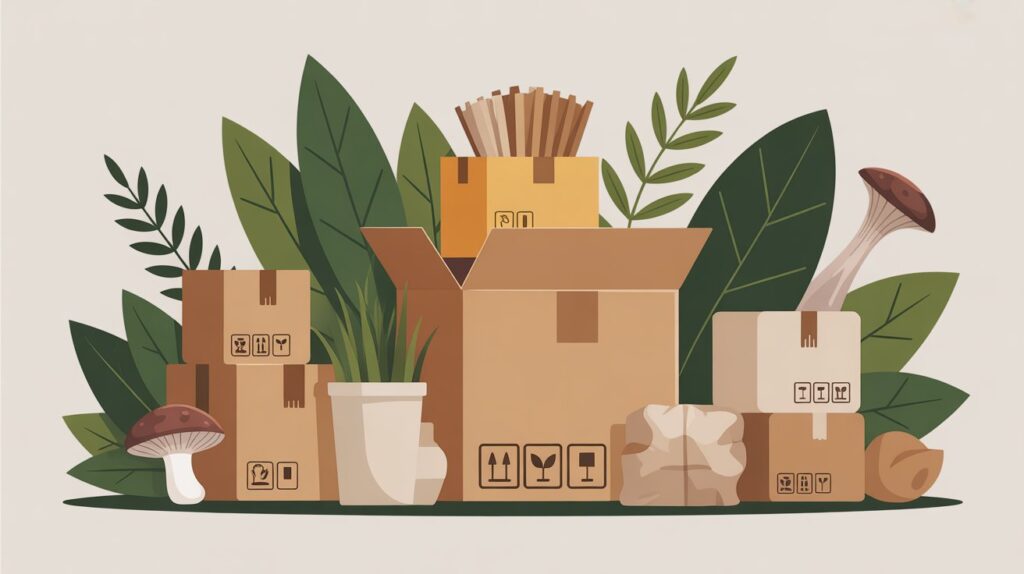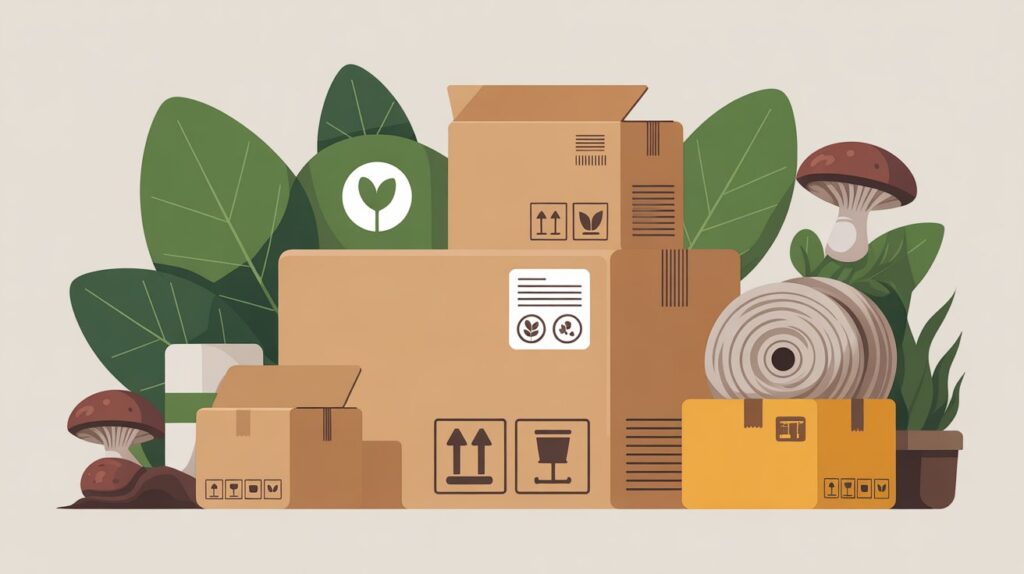The rise of digital commerce has transformed how consumers shop and how businesses operate. Millions of packages are shipped daily, but with this convenience comes an undeniable environmental cost. Excess packaging, single-use plastics, and oversized boxes have created an unprecedented surge in waste. This makes sustainable packaging not just a trend, but a necessity for businesses that want to stay relevant, responsible, and profitable in the years ahead.
Consumers now expect businesses to adopt practices that align with sustainability. Regulations are tightening, and supply chains are shifting toward greener alternatives. For online retailers, adopting sustainable packaging solutions for eCommerce is no longer optional—it’s a strategic move that enhances brand loyalty, reduces costs, and protects the planet.
This expanded guide (3,500+ words) provides a deep dive into every aspect of sustainable packaging for online businesses. It includes definitions, principles, material options, strategies, case studies, challenges, solutions, and future trends. Whether you run a small online shop or a global marketplace, this resource will help you build packaging strategies that are effective, compliant, and environmentally responsible.
What Is Sustainable Packaging?
Sustainable packaging refers to materials and designs that minimize environmental impact throughout their entire lifecycle—from sourcing and production to use and disposal. It focuses on resource efficiency, waste reduction, and the transition to a circular economy.
Key attributes of sustainable packaging include:
- Recyclability: Materials that can be collected, processed, and reused to make new products.
- Compostability: Packaging that safely breaks down into natural elements without harming the environment.
- Reusability: Durable packaging designed for multiple uses, reducing single-use waste.
- Renewable sourcing: Materials derived from sustainable sources like responsibly managed forests or fast-growing crops.
- Reduced resource consumption: Packaging designs that require fewer materials and less energy to produce.
Sustainability also considers logistics, such as how packaging affects transport emissions, warehouse efficiency, and consumer disposal habits.
Why Sustainable Packaging Matters in eCommerce
The Scale of the Problem
The explosion of eCommerce has resulted in packaging waste becoming one of the fastest-growing waste streams worldwide. Every additional layer of bubble wrap, oversized cardboard box, or plastic filler contributes to landfill buildup and greenhouse gas emissions.
Consumer Expectations
Studies show that 74% of consumers are willing to pay more for sustainable packaging, while over 50% actively avoid brands that fail to meet environmental standards. Packaging has become an extension of brand identity—it communicates values as much as the product itself.
Business Efficiency
Eco-friendly packaging is often lighter, smaller, and more efficient. By right-sizing packaging and eliminating excess material, businesses save money on raw materials, shipping, and warehousing.
Regulatory Compliance
From the EU’s Packaging and Packaging Waste Directive to single-use plastic bans across Asia, regulations are tightening. Non-compliance risks fines, loss of consumer trust, and barriers to entering certain markets.
Long-Term Brand Value
Adopting sustainable packaging enhances corporate reputation, strengthens ESG performance, and future-proofs businesses against evolving market demands.
Key Principles of Sustainable Packaging Design
- Reduce First, Replace Second
Prioritize reducing the amount of packaging before exploring alternative materials. - Right-Sizing
Optimize box and mailer sizes to minimize void fill and shipping inefficiencies. - Design for Reuse
Encourage packaging that customers can repurpose for storage, returns, or secondary shipping. - Material Innovation
Explore compostables, plant-based solutions, and recycled content. - Circular Economy Alignment
Ensure packaging can re-enter the economy via recycling, composting, or reuse. - Clear Labeling
Educate customers on how to dispose of packaging properly with visible, understandable instructions.
Types of Sustainable Packaging Materials
Recycled Paper and Cardboard
- Made from post-consumer waste.
- Strong, durable, and widely recyclable.
- Ideal for boxes, cartons, inserts, and protective layers.
Biodegradable Plastics (Bioplastics)
- Derived from plants like corn or sugarcane.
- Decompose faster than petroleum-based plastics.
- Suitable for poly mailers and bags.
Compostable Mailers
- Break down under composting conditions.
- Certified options ensure safe decomposition.
- Excellent for clothing, accessories, and lightweight goods.
Plant-Based Alternatives (Mushroom, Seaweed, Algae)
- Mushroom packaging can replace Styrofoam inserts.
- Seaweed films provide moisture-resistant wrapping.
- Algae-based plastics offer renewable, biodegradable substitutes.
Reusable Packaging
- Designed for multiple shipping cycles.
- Often implemented in subscription models and rental businesses.
- Reduces material waste significantly in closed-loop systems.
Minimalist / Frustration-Free Packaging
- Simple designs without excess filler.
- Easy for consumers to open, store, and recycle.
- Often encouraged by platforms like Amazon to improve efficiency.
Strategies for Reducing Packaging Waste
Right-Sizing and Smart Packaging
Oversized boxes waste material and increase shipping emissions. Automated right-sizing machines are now widely used to customize box dimensions per product.
Multi-Use and Returnable Packaging
Brands can design packaging that serves as both shipping container and return mailer. This approach saves money and reduces customer hassle.
Lightweight Packaging
Switching from heavier cardboard to durable paper mailers reduces overall shipping weight, lowering carbon footprints.
Eliminating Plastic Fillers
Replacing bubble wrap with paper honeycomb wrap, shredded cardboard, or cornstarch peanuts drastically reduces non-recyclable waste.
Minimal Printing and Eco-Inks
Using water-based or soy-based inks ensures packaging remains recyclable and less toxic.
Challenges of Adopting Sustainable Packaging
Higher Upfront Costs
Eco-friendly materials may cost more initially. However, operational efficiencies and consumer loyalty often offset these expenses.
Limited Supplier Networks
Access to certified sustainable packaging suppliers varies by region, making global adoption uneven.
Consumer Confusion
Many consumers struggle to distinguish between recyclable, biodegradable, and compostable options, leading to incorrect disposal.
Recycling Infrastructure Gaps
Even when recyclable, packaging often ends up in landfill if municipal infrastructure is lacking.
Greenwashing Risks
Brands that make unverified sustainability claims risk reputational damage and even legal repercussions.
Case Studies of Brands Using Sustainable Packaging
Case Study 1: Global Apparel Brand
A major fashion retailer replaced plastic poly mailers with FSC-certified paper mailers. Within one year, they eliminated over 200 tons of virgin plastic.
Case Study 2: Boutique Skincare Company
A small eCommerce brand switched to compostable mailers and introduced a return-and-reuse program. This not only reduced waste but also became a strong marketing differentiator.
Case Study 3: Electronics Manufacturer
By redesigning its packaging to fit products snugly and eliminate Styrofoam, a tech company cut packaging volume by 30%, reducing shipping costs and emissions.
Case Study 4: Subscription Box Service
A subscription service switched to fully recyclable boxes and minimal inserts. Customer satisfaction increased because the packaging was easier to dispose of responsibly.
Implementation Roadmap for Businesses
- Conduct a Packaging Audit
Review current materials, costs, and consumer feedback. - Set Clear Sustainability Goals
Example: “Reduce virgin plastic use by 40% within two years.” - Research and Vet Suppliers
Look for certifications (FSC, BPI, EN 13432). - Pilot Sustainable Options
Test new packaging with select products or regions before scaling. - Educate Consumers
Use labels and website guides to explain proper disposal. - Measure and Report
Track environmental impact and communicate results to stakeholders.
Future Trends in Sustainable eCommerce Packaging
- Reusable Delivery Models: Brands offering incentives for customers to return packaging for reuse.
- Smart Packaging: QR codes that guide customers to recycling instructions and track packaging reuse.
- Advanced Materials: Biodegradable films with moisture resistance, edible coatings, and algae-based plastics.
- Circular Partnerships: Businesses collaborating with recycling facilities and logistics providers to close the loop.
- AI-Driven Packaging Optimization: Software that analyzes product dimensions, shipping routes, and waste reduction opportunities.
FAQs on Sustainable Packaging Solutions for eCommerce
1. What is the most sustainable packaging for eCommerce?
The most sustainable option depends on your product type and shipping needs. Recycled cardboard boxes are highly versatile, while compostable mailers are best for lightweight items like clothing. Mushroom packaging and seaweed-based films are innovative alternatives for protective wrapping.
2. Does sustainable packaging cost more than traditional packaging?
Yes, in many cases eco-friendly packaging materials are slightly more expensive upfront. However, cost savings from lighter shipments, reduced storage needs, and increased customer loyalty often balance or exceed these expenses over time.
3. How can small eCommerce businesses adopt sustainable packaging affordably?
Small businesses can start by switching to recycled cardboard, eliminating excess fillers, and right-sizing boxes. Many suppliers now offer compostable mailers and eco-friendly inserts in smaller bulk quantities tailored to small retailers.
4. Which certifications should businesses look for in eco-friendly packaging?
Trusted certifications include FSC (Forest Stewardship Council) for paper products, BPI (Biodegradable Products Institute) for compostables, and EN 13432 or ASTM D6400 for compostable plastics. These labels verify that materials meet global sustainability standards.
5. Can sustainable packaging improve customer satisfaction?
Absolutely. Research shows that customers perceive eco-friendly packaging as an extension of a brand’s values. Clear labeling, easy recyclability, and minimal waste contribute to positive unboxing experiences and repeat purchases.
6. What role do consumers play in packaging sustainability?
Consumers are a critical part of the cycle. Even the best packaging is wasted if not disposed of correctly. Brands should provide clear instructions—through labels, inserts, or QR codes—on how to recycle or compost their packaging.
Conclusion
The global eCommerce industry is expanding rapidly, and with it comes the challenge of reducing packaging waste. Businesses can no longer ignore the environmental and reputational risks of excessive, non-recyclable packaging. Embracing sustainable packaging solutions for eCommerce is not only a matter of compliance—it is a forward-looking strategy that builds resilience, cuts costs, and strengthens brand trust.
By investing in right-sizing, innovative materials, circular models, and consumer education, businesses can transform packaging from a liability into a competitive advantage. Those who lead in this space will not only meet rising consumer expectations but also position themselves as industry pioneers in a greener, more responsible future.












